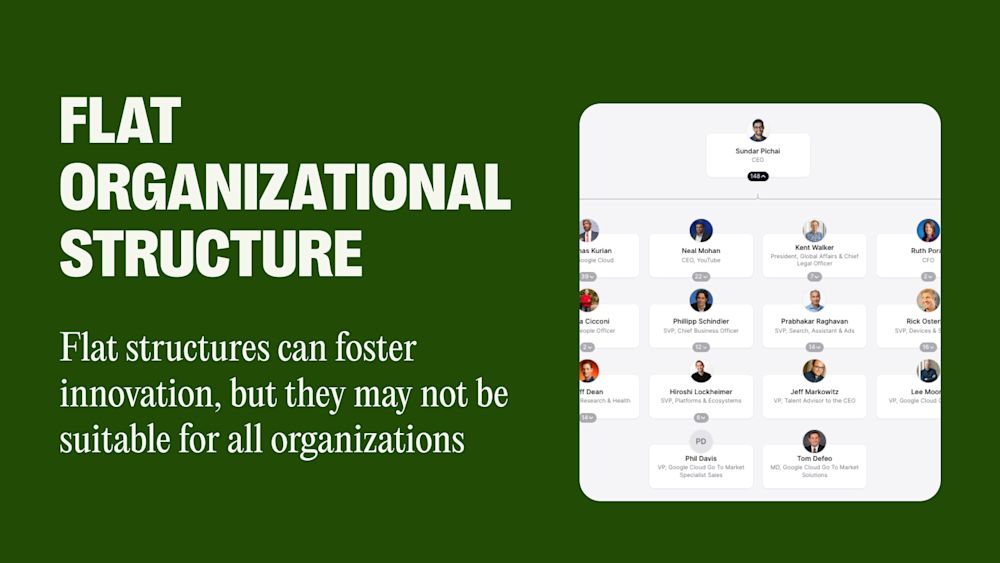Table of contents
In this blog post, youŌĆÖll learn about the characteristics that define a flat organizational structure. WeŌĆÖll highlight the pros and cons, and introduce you to a company that succeeded in operating with a flat structure.

Implementing a flat organizational structure increased in popularity with the rise of technology startups in the late 20th century. The structure allows for employee engagement to increase, bureaucracy to be eliminated, and the organization to become more effective.
Flat structures can foster innovation, but they come with a price and may not be suitable for all organizations.
LetŌĆÖs dive into it!
What is a flat organizational structure?
In a flat organizational structure, the middle management found in traditional companies has been removed or limited to a minimum. In practice, this means that there is a short chain of command from staff to executives.
The goal of a flat structure is to have as little hierarchy in the organization as possible. Due to this defining characteristic, which is based on the notion that bureaucracy kills innovation, flat structures are often found in fast-moving tech startups.
Pros and cons of a flat organizational structure
There are several advantages of operating with a flat organizational structure in a company. However, the lack of a hierarchy can also lead to issues within the organization. Here are some of the pros and cons of a flat organizational structure:
Pros
- Increased employee autonomy and ownership
A flat management structure allows for more employee autonomy and ownership. This can increase satisfaction for employees as they feel more trusted by the executive team. More satisfaction leads to higher well-being, as employees are free to manage their workload and work-life balance.
In turn, this can lead to higher levels of innovation since employees are not constantly managed, but rather left to find their own solutions. More trust, autonomy, and responsibility can also create a strong commitment to the company ŌĆö and that often equals a higher employee retention rate.
- Leaner organization
A flat structure has little or no middle management. By removing this layer from the organization, expenses decrease and the organization can operate in a more cost-effective way.
- More efficient communication
Every organization needs internal communication. In traditional organizational structures, many layers of management can lead to slow communication, which can decrease efficiency and increase the risk of miscommunication.
A flat organizational structure deals with these challenges by limiting the chain of command, decreasing bureaucracy and allowing for faster, more precise communication between team members. Decision-making is distributed across teams, leading to more autonomy for each employee and more direct communication between them.
Cons
- Not suitable for larger companies
One of the main reasons why a flat structure may not be feasible for a larger organization is the lack of a hierarchy. Not having a hierarchy in larger organizations can lead to confusion as to who has the decision-making power and who is responsible for different tasks.
- Lack of advancement opportunities
The lack of layers in a flat hierarchy means fewer opportunities for promotion. Limited advancement opportunities can result in decreased employee retention, as employees may be demotivated by having no clear path forward to advancing their careers.
- Informal layers can emerge
In theory, employees in a flat organizational structure will have equal status and decision-making authority.
In practice, however, factors such as experience, personal relationships, culture, or leadership qualities possessed by some employees can lead to the emergence of informal hierarchies with de-facto managers, undermining the flat structure of the organization.
Examples of companies with a flat organizational structure
An example of a company that operates with a flat organizational structure is the American video game developer Valve, maker of the video game distribution service Steam and games such as Counter-Strike, Half-Life, and Dota.
Valve used to operate under a hierarchy. When launching Steam, the company found that this traditional organizational structure was hindering progress. According to Valve co-founder Gabe Newell, a flat structure had a positive effect on the company, as it allowed employees to work on projects they were passionate about while increasing their sense of responsibility.
Conclusion
Some management experts see flat hierarchies as a structure that will increase in popularity in the future. This is due to the progressive nature of flat management structures that allows for more employee engagement and fewer layers, which can result in a leaner, more effective organization.
However, flat structures have their downsides. With Valve as a notable exception, most larger companies cannot operate without a hierarchy as their business operations increase in complexity. In conclusion, a flat organizational structure is most suitable for small companies.
Want to learn more about organizational structures? At The Org, we have the worldŌĆÖs largest network of publicly available org charts and a ton of resources that will teach you more about management, organizational design, and how you can make your own org chart.


The ┬▄└“┬ę┬ū helps
you hire great
candidates
Free to use ŌĆō try today